Environmental Hazards Advisory Plan: Nechako River Water Pollution
VerifiedAdded on 2022/08/27
|10
|2704
|16
Report
AI Summary
This report, prepared for Mr. James Pearson, an Earth First Environmental Consulting Company client, evaluates potential water pollution hazards in the Nechako River. The report identifies multiple sources of pollution, including a Kraft pulp mill, agricultural runoff from farms using fertilizers and pesticides, and a zinc/lead mine and smelter, all located upstream from Mr. Pearson's proposed water intake. It examines the impacts of climate change and fossil fuel development on water quality and details the types of pollutants present, such as microplastics. The report highlights potential health hazards, including increased freshwater temperatures, bacterial diseases, and the disruption of marine ecosystems and food chains. It provides a thesis statement outlining the company's advisory role and concludes with recommendations for mitigating these hazards, emphasizing the importance of disseminating findings and facilitating a multi-interest process to improve the health of the Nechako River watershed.
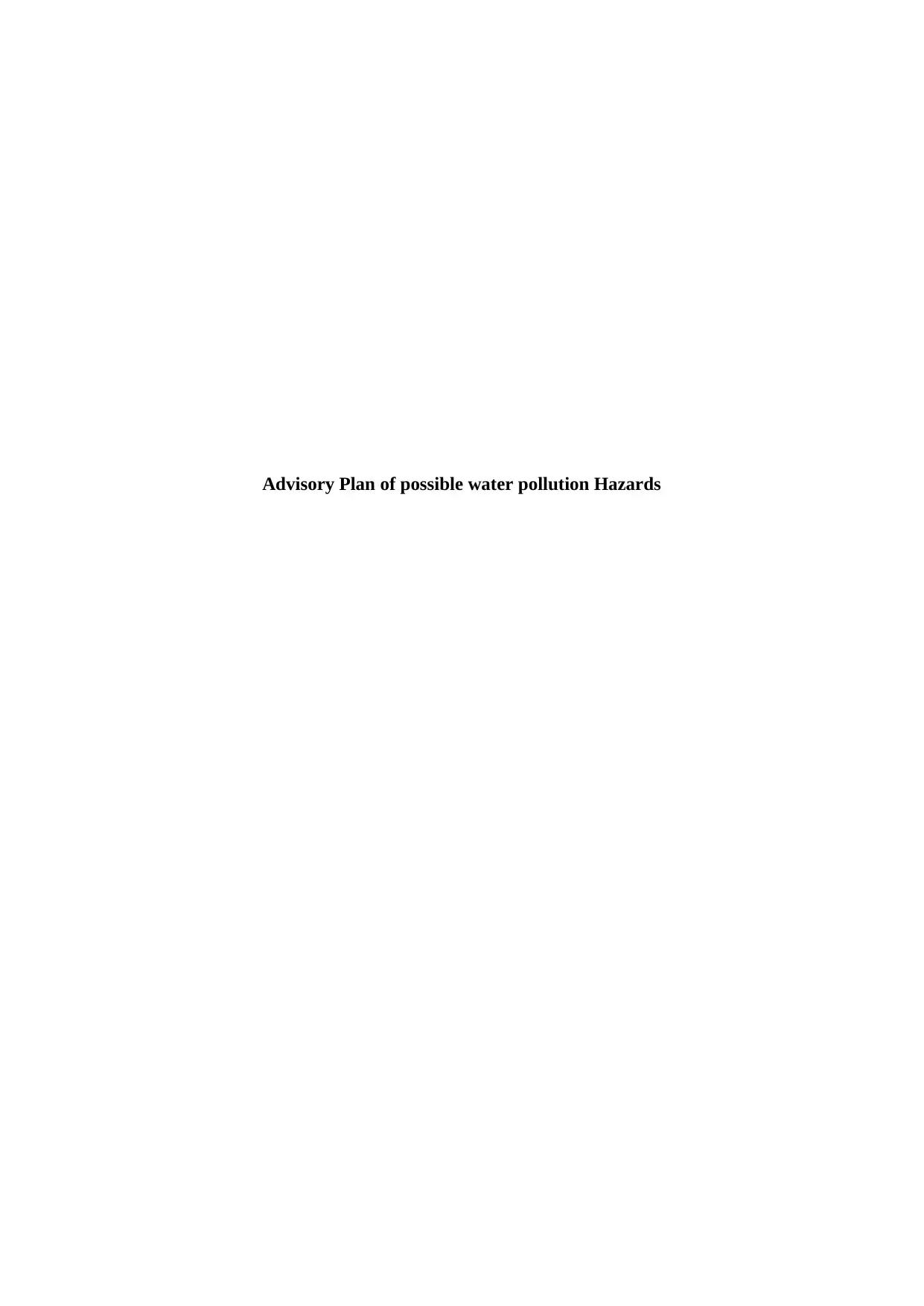
Advisory Plan of possible water pollution Hazards
Paraphrase This Document
Need a fresh take? Get an instant paraphrase of this document with our AI Paraphraser
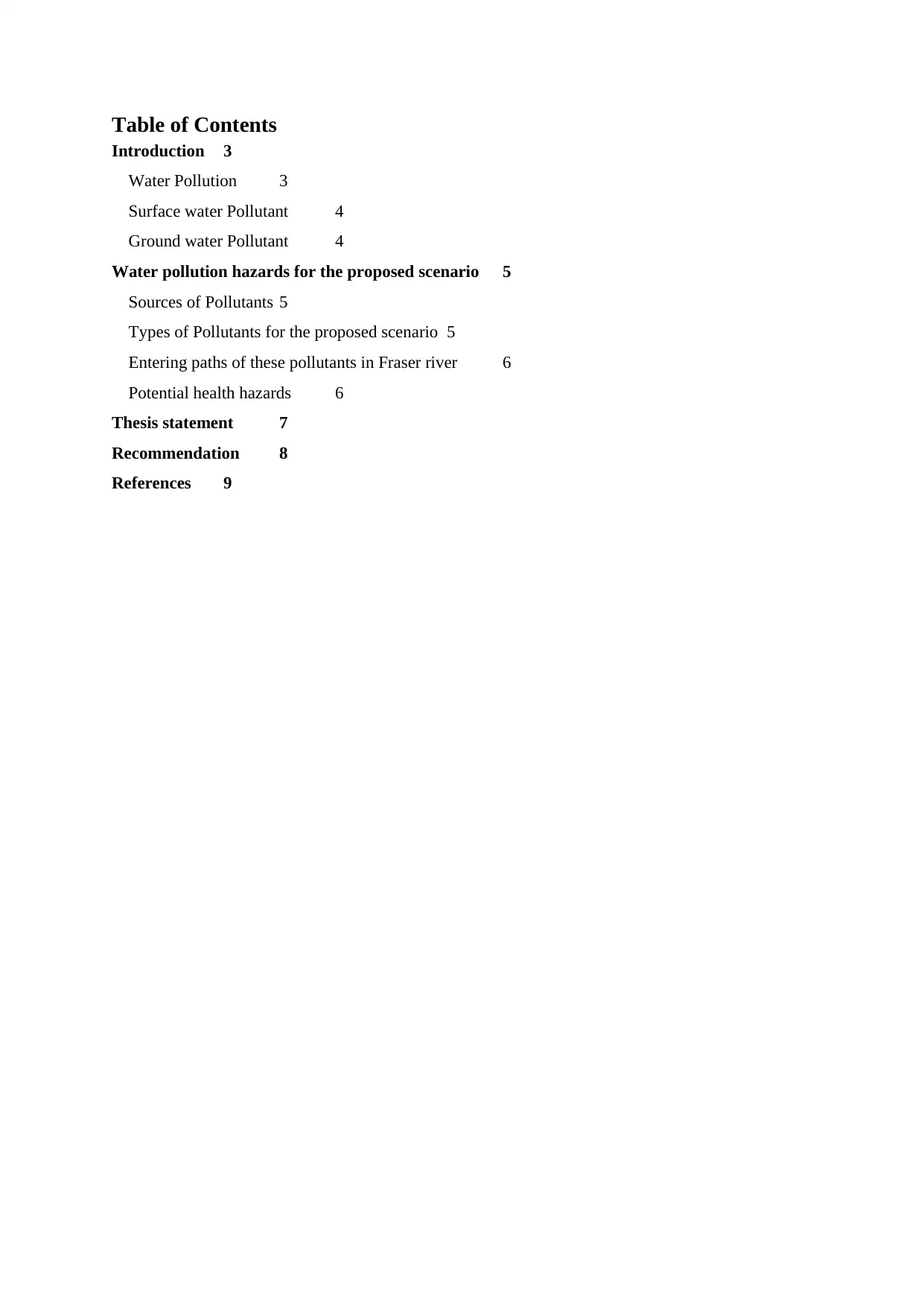
Table of Contents
Introduction 3
Water Pollution 3
Surface water Pollutant 4
Ground water Pollutant 4
Water pollution hazards for the proposed scenario 5
Sources of Pollutants 5
Types of Pollutants for the proposed scenario 5
Entering paths of these pollutants in Fraser river 6
Potential health hazards 6
Thesis statement 7
Recommendation 8
References 9
Introduction 3
Water Pollution 3
Surface water Pollutant 4
Ground water Pollutant 4
Water pollution hazards for the proposed scenario 5
Sources of Pollutants 5
Types of Pollutants for the proposed scenario 5
Entering paths of these pollutants in Fraser river 6
Potential health hazards 6
Thesis statement 7
Recommendation 8
References 9
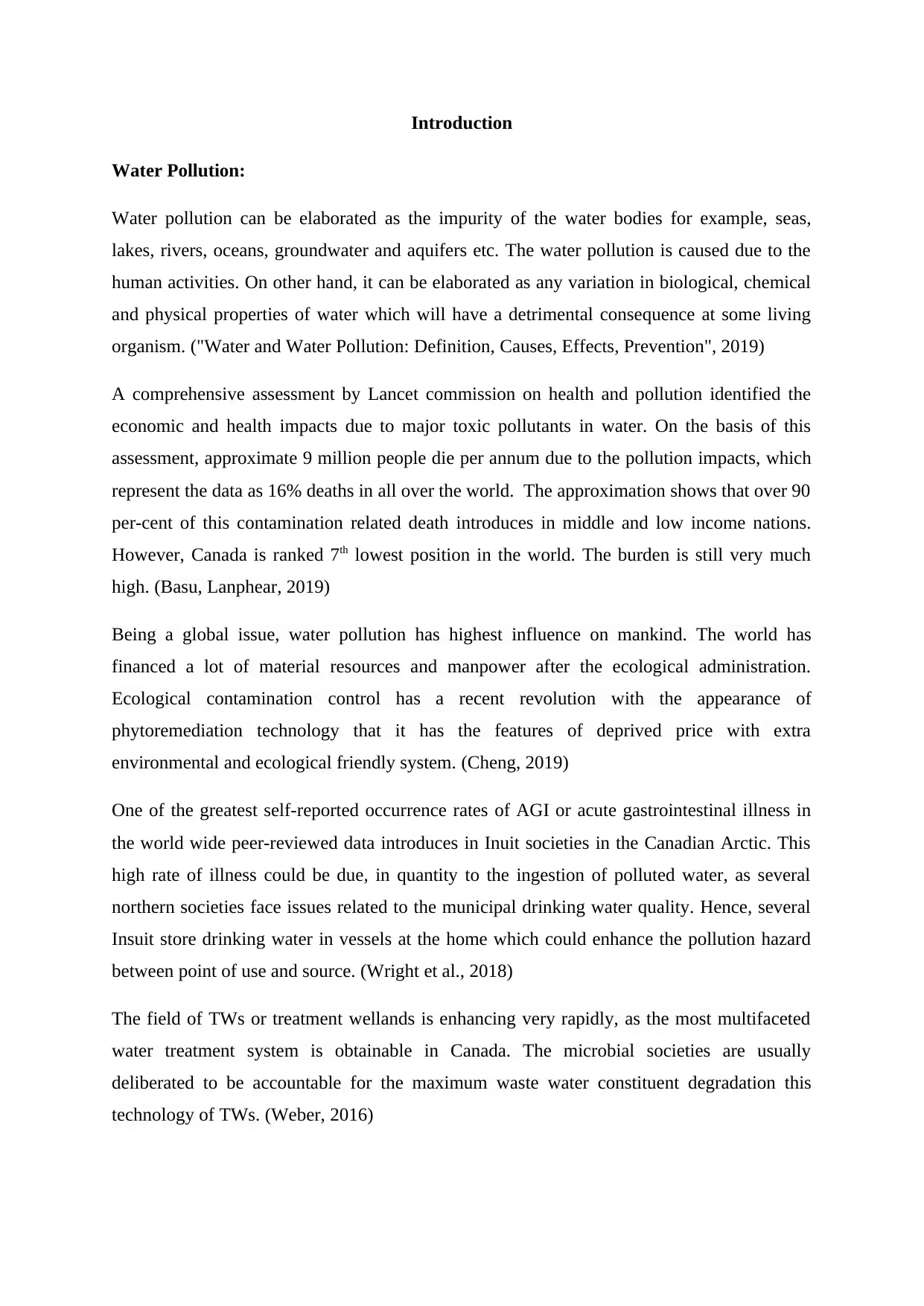
Introduction
Water Pollution:
Water pollution can be elaborated as the impurity of the water bodies for example, seas,
lakes, rivers, oceans, groundwater and aquifers etc. The water pollution is caused due to the
human activities. On other hand, it can be elaborated as any variation in biological, chemical
and physical properties of water which will have a detrimental consequence at some living
organism. ("Water and Water Pollution: Definition, Causes, Effects, Prevention", 2019)
A comprehensive assessment by Lancet commission on health and pollution identified the
economic and health impacts due to major toxic pollutants in water. On the basis of this
assessment, approximate 9 million people die per annum due to the pollution impacts, which
represent the data as 16% deaths in all over the world. The approximation shows that over 90
per-cent of this contamination related death introduces in middle and low income nations.
However, Canada is ranked 7th lowest position in the world. The burden is still very much
high. (Basu, Lanphear, 2019)
Being a global issue, water pollution has highest influence on mankind. The world has
financed a lot of material resources and manpower after the ecological administration.
Ecological contamination control has a recent revolution with the appearance of
phytoremediation technology that it has the features of deprived price with extra
environmental and ecological friendly system. (Cheng, 2019)
One of the greatest self-reported occurrence rates of AGI or acute gastrointestinal illness in
the world wide peer-reviewed data introduces in Inuit societies in the Canadian Arctic. This
high rate of illness could be due, in quantity to the ingestion of polluted water, as several
northern societies face issues related to the municipal drinking water quality. Hence, several
Insuit store drinking water in vessels at the home which could enhance the pollution hazard
between point of use and source. (Wright et al., 2018)
The field of TWs or treatment wellands is enhancing very rapidly, as the most multifaceted
water treatment system is obtainable in Canada. The microbial societies are usually
deliberated to be accountable for the maximum waste water constituent degradation this
technology of TWs. (Weber, 2016)
Water Pollution:
Water pollution can be elaborated as the impurity of the water bodies for example, seas,
lakes, rivers, oceans, groundwater and aquifers etc. The water pollution is caused due to the
human activities. On other hand, it can be elaborated as any variation in biological, chemical
and physical properties of water which will have a detrimental consequence at some living
organism. ("Water and Water Pollution: Definition, Causes, Effects, Prevention", 2019)
A comprehensive assessment by Lancet commission on health and pollution identified the
economic and health impacts due to major toxic pollutants in water. On the basis of this
assessment, approximate 9 million people die per annum due to the pollution impacts, which
represent the data as 16% deaths in all over the world. The approximation shows that over 90
per-cent of this contamination related death introduces in middle and low income nations.
However, Canada is ranked 7th lowest position in the world. The burden is still very much
high. (Basu, Lanphear, 2019)
Being a global issue, water pollution has highest influence on mankind. The world has
financed a lot of material resources and manpower after the ecological administration.
Ecological contamination control has a recent revolution with the appearance of
phytoremediation technology that it has the features of deprived price with extra
environmental and ecological friendly system. (Cheng, 2019)
One of the greatest self-reported occurrence rates of AGI or acute gastrointestinal illness in
the world wide peer-reviewed data introduces in Inuit societies in the Canadian Arctic. This
high rate of illness could be due, in quantity to the ingestion of polluted water, as several
northern societies face issues related to the municipal drinking water quality. Hence, several
Insuit store drinking water in vessels at the home which could enhance the pollution hazard
between point of use and source. (Wright et al., 2018)
The field of TWs or treatment wellands is enhancing very rapidly, as the most multifaceted
water treatment system is obtainable in Canada. The microbial societies are usually
deliberated to be accountable for the maximum waste water constituent degradation this
technology of TWs. (Weber, 2016)
⊘ This is a preview!⊘
Do you want full access?
Subscribe today to unlock all pages.

Trusted by 1+ million students worldwide

Mining is a main economy development contributor in South African countries. However,
despite of the economic development, it is also a major source of water pollution because
mining process is prevalent in most of the country’s water catchments (Muruben & Tekere,
2020).
On the basis of data, industrial and the agricultural operations are produced approximate 1.1
trillion m3 of waste water in 2009 and this amount of pollution leads to grow. (Incera,
Avelino & Solis, 2017)
Surface water Pollutants:
Surface water pollution can be defined as the pollution of aquatic system which introduces at
the above level of ground, for example, lakes, rivers and streams etc. The major reason of this
type of pollution is polluted rainwater. It means when the rainwater runoff carries the
pollutants then this type of pollution occurs. These pollutants are transport by runoff from
city on various things such as, salt, chemicals, fertilizers and nutrients etc.
When the reasons of this pollution occurrence are fertilizers and nutrients, then it can also be
termed as nutrient pollution. It enhances the overproduction of aquatic plants and the algae,
which causes various problems. It covers the water surface, which prevent the sunlight to be
reached at plants underwater. This can show the outcome as less oxygen production which
causes harm to breathing organism in water such as fishes. (D, "Water Pollution: Definition,
Types, and Sources")
Ground water Pollutants:
Ground water pollution introduces when the man-made products such as, road salts, oil,
gasoline and chemicals etc. get mixed into the ground water. This association become unfit or
unsafe for the human usage.
There are several materials which move from the land’s surface and get mixed with the
groundwater such as, fertilizers, pesticides. These materials are known as the groundwater
pollutants. On the other hand, there are a lot of untreated wastes from the toxic chemicals
which also get mixed with the ground water.
despite of the economic development, it is also a major source of water pollution because
mining process is prevalent in most of the country’s water catchments (Muruben & Tekere,
2020).
On the basis of data, industrial and the agricultural operations are produced approximate 1.1
trillion m3 of waste water in 2009 and this amount of pollution leads to grow. (Incera,
Avelino & Solis, 2017)
Surface water Pollutants:
Surface water pollution can be defined as the pollution of aquatic system which introduces at
the above level of ground, for example, lakes, rivers and streams etc. The major reason of this
type of pollution is polluted rainwater. It means when the rainwater runoff carries the
pollutants then this type of pollution occurs. These pollutants are transport by runoff from
city on various things such as, salt, chemicals, fertilizers and nutrients etc.
When the reasons of this pollution occurrence are fertilizers and nutrients, then it can also be
termed as nutrient pollution. It enhances the overproduction of aquatic plants and the algae,
which causes various problems. It covers the water surface, which prevent the sunlight to be
reached at plants underwater. This can show the outcome as less oxygen production which
causes harm to breathing organism in water such as fishes. (D, "Water Pollution: Definition,
Types, and Sources")
Ground water Pollutants:
Ground water pollution introduces when the man-made products such as, road salts, oil,
gasoline and chemicals etc. get mixed into the ground water. This association become unfit or
unsafe for the human usage.
There are several materials which move from the land’s surface and get mixed with the
groundwater such as, fertilizers, pesticides. These materials are known as the groundwater
pollutants. On the other hand, there are a lot of untreated wastes from the toxic chemicals
which also get mixed with the ground water.
Paraphrase This Document
Need a fresh take? Get an instant paraphrase of this document with our AI Paraphraser
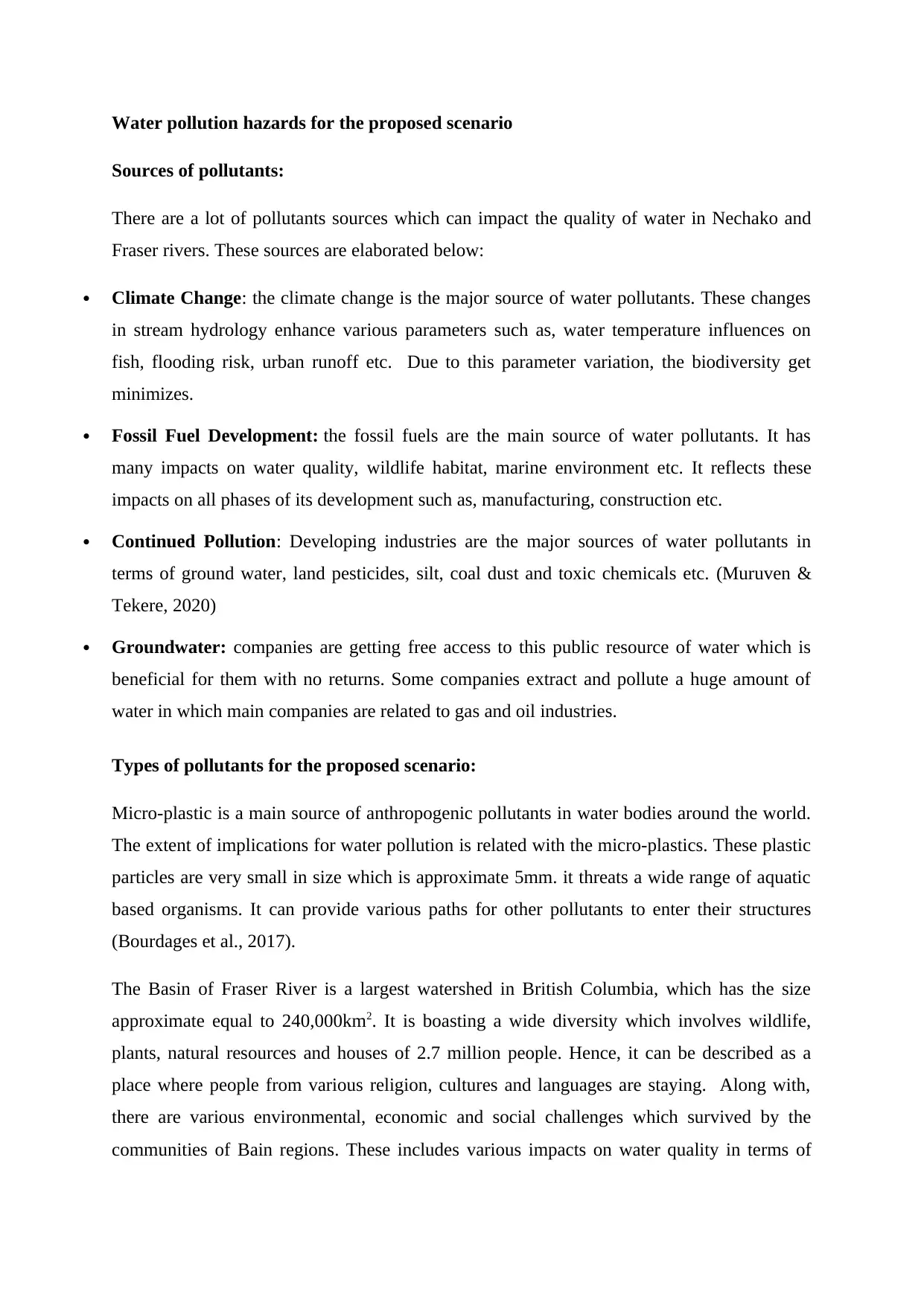
Water pollution hazards for the proposed scenario
Sources of pollutants:
There are a lot of pollutants sources which can impact the quality of water in Nechako and
Fraser rivers. These sources are elaborated below:
Climate Change: the climate change is the major source of water pollutants. These changes
in stream hydrology enhance various parameters such as, water temperature influences on
fish, flooding risk, urban runoff etc. Due to this parameter variation, the biodiversity get
minimizes.
Fossil Fuel Development: the fossil fuels are the main source of water pollutants. It has
many impacts on water quality, wildlife habitat, marine environment etc. It reflects these
impacts on all phases of its development such as, manufacturing, construction etc.
Continued Pollution: Developing industries are the major sources of water pollutants in
terms of ground water, land pesticides, silt, coal dust and toxic chemicals etc. (Muruven &
Tekere, 2020)
Groundwater: companies are getting free access to this public resource of water which is
beneficial for them with no returns. Some companies extract and pollute a huge amount of
water in which main companies are related to gas and oil industries.
Types of pollutants for the proposed scenario:
Micro-plastic is a main source of anthropogenic pollutants in water bodies around the world.
The extent of implications for water pollution is related with the micro-plastics. These plastic
particles are very small in size which is approximate 5mm. it threats a wide range of aquatic
based organisms. It can provide various paths for other pollutants to enter their structures
(Bourdages et al., 2017).
The Basin of Fraser River is a largest watershed in British Columbia, which has the size
approximate equal to 240,000km2. It is boasting a wide diversity which involves wildlife,
plants, natural resources and houses of 2.7 million people. Hence, it can be described as a
place where people from various religion, cultures and languages are staying. Along with,
there are various environmental, economic and social challenges which survived by the
communities of Bain regions. These includes various impacts on water quality in terms of
Sources of pollutants:
There are a lot of pollutants sources which can impact the quality of water in Nechako and
Fraser rivers. These sources are elaborated below:
Climate Change: the climate change is the major source of water pollutants. These changes
in stream hydrology enhance various parameters such as, water temperature influences on
fish, flooding risk, urban runoff etc. Due to this parameter variation, the biodiversity get
minimizes.
Fossil Fuel Development: the fossil fuels are the main source of water pollutants. It has
many impacts on water quality, wildlife habitat, marine environment etc. It reflects these
impacts on all phases of its development such as, manufacturing, construction etc.
Continued Pollution: Developing industries are the major sources of water pollutants in
terms of ground water, land pesticides, silt, coal dust and toxic chemicals etc. (Muruven &
Tekere, 2020)
Groundwater: companies are getting free access to this public resource of water which is
beneficial for them with no returns. Some companies extract and pollute a huge amount of
water in which main companies are related to gas and oil industries.
Types of pollutants for the proposed scenario:
Micro-plastic is a main source of anthropogenic pollutants in water bodies around the world.
The extent of implications for water pollution is related with the micro-plastics. These plastic
particles are very small in size which is approximate 5mm. it threats a wide range of aquatic
based organisms. It can provide various paths for other pollutants to enter their structures
(Bourdages et al., 2017).
The Basin of Fraser River is a largest watershed in British Columbia, which has the size
approximate equal to 240,000km2. It is boasting a wide diversity which involves wildlife,
plants, natural resources and houses of 2.7 million people. Hence, it can be described as a
place where people from various religion, cultures and languages are staying. Along with,
there are various environmental, economic and social challenges which survived by the
communities of Bain regions. These includes various impacts on water quality in terms of

using the natural resources, ecosystems strains, demographics changes and enhancing
demands for the public services (Marshall, Litke & Fresco, 2017).
Hence, both kinds of water pollutants are available in Fraser River and Nechako River as,
ground water pollutants and surface water pollutants etc. Hence, it can impact the water
supply system of Mr Pearson.
Entering paths of these pollutants in Fraser River:
The Nechako River is one of the main branches to the Fraser River. Hence, it affects its water
quality and hydrology as well. Nechako River’s headwaters are situated in the Nechako
reservoir drainage basin and its flow at the upper watershed is controlled through a Dam
which named as Kenney Dam. The drainage area of this river is having the size of 46,000km2
and it is located at Prince George. The water quality of Nechako River is impacted by many
other rivers as well such as, Chlako, Nautley and Stuart rivers. The water of Nechako River
are applicable in various operations such as, boating, swimming, aquatic life, wildlife etc.
(Swain & Eng., "WATER QUALITY ASSESSMENT OF Nechako River AT PRINCE
GEORGE")
Potential health hazards:
The summary shown below elaborates about the top threats in water, land, people’s culture and
quality of life.
Freshwater temperature:
Temperature is the major environmental element which affects the health of marine and other
cold-blooded marines’ organisms. Enhancement in water temperature at 200C or more than
that can contribute in the pre-mortality rate in Sockeye salmon by eliminating the swimming
ability, migration impending and energy depletion more rapidly. Such as, a study by UBC
physiology elaborated that the early run population at the nearby region of Nechako start to
experience the impaired physiology between 200C -220C. On the basis of this studies’
prediction it would be possible that population would be unable to swim and they would die
soon at temperature of 24- 260C ("Nechako Watershed Health Report", 2015).
Bacterial disease:
The main cause of bacterial disease such as, Diarrhea is the main reason of untreated drinking
water and fecal pollutants. This kind of disease is caused due to the polluted water. the
demands for the public services (Marshall, Litke & Fresco, 2017).
Hence, both kinds of water pollutants are available in Fraser River and Nechako River as,
ground water pollutants and surface water pollutants etc. Hence, it can impact the water
supply system of Mr Pearson.
Entering paths of these pollutants in Fraser River:
The Nechako River is one of the main branches to the Fraser River. Hence, it affects its water
quality and hydrology as well. Nechako River’s headwaters are situated in the Nechako
reservoir drainage basin and its flow at the upper watershed is controlled through a Dam
which named as Kenney Dam. The drainage area of this river is having the size of 46,000km2
and it is located at Prince George. The water quality of Nechako River is impacted by many
other rivers as well such as, Chlako, Nautley and Stuart rivers. The water of Nechako River
are applicable in various operations such as, boating, swimming, aquatic life, wildlife etc.
(Swain & Eng., "WATER QUALITY ASSESSMENT OF Nechako River AT PRINCE
GEORGE")
Potential health hazards:
The summary shown below elaborates about the top threats in water, land, people’s culture and
quality of life.
Freshwater temperature:
Temperature is the major environmental element which affects the health of marine and other
cold-blooded marines’ organisms. Enhancement in water temperature at 200C or more than
that can contribute in the pre-mortality rate in Sockeye salmon by eliminating the swimming
ability, migration impending and energy depletion more rapidly. Such as, a study by UBC
physiology elaborated that the early run population at the nearby region of Nechako start to
experience the impaired physiology between 200C -220C. On the basis of this studies’
prediction it would be possible that population would be unable to swim and they would die
soon at temperature of 24- 260C ("Nechako Watershed Health Report", 2015).
Bacterial disease:
The main cause of bacterial disease such as, Diarrhea is the main reason of untreated drinking
water and fecal pollutants. This kind of disease is caused due to the polluted water. the
⊘ This is a preview!⊘
Do you want full access?
Subscribe today to unlock all pages.

Trusted by 1+ million students worldwide

bacteria introduce from this polluted water produces toxins in digestive tracts (Haseena,
2017)
Death of marine animals:
The major problem caused due to water pollution is the death of marine animals. These
marine animals depend upon the water bodies. There are several marine animals such as,
crabs, fish, sea gulls, dolphins etc. which killed by the pollutants in their habitat or living
environment.
Food chain disruption:
Pollution disrupts the food chain by the toxin movement form one level to another. In some
cases, pollution can spread out a whole part of the food chain. It impact on the other organism
as well by causing the excessive development, in case of the mortality rate.
Destruction of ecosystems:
The elimination and introduction of some microorganisms destroys the ecosystem. It can also
be termed as the nutrient pollution. Such as, it leads the enhancement of algae, which
minimizes the oxygen level in water. It leads the death of marine animals and aquatic life.
Economic effects:
Restoring ad managing the polluted water bodies is expensive. Such as, it runs out of space.
On the basis of research, the economy is differing from the same because it is having the cost
of 600$ to clean up the impact of disaster.
Thesis statement
This thesis is written as an employee of the Earth First Environmental Consulting Company.
A new landowner, Mr James Pearson, has retained the services of the company. Mr Pearson
has recently applied for a permit to remove water from the Nechako River for personal use
and for watering his herd of bison. It is the major responsibility to advise the landowner of
possible water pollution hazards. One mile upstream from his proposed intake is the
"LOWEST COST IS OUR GUARANTEE”, Kraft pulp mill and detergent factory. This mill
deposits its liquid effluent and treated sewage directly into the Nechako River. Five miles
2017)
Death of marine animals:
The major problem caused due to water pollution is the death of marine animals. These
marine animals depend upon the water bodies. There are several marine animals such as,
crabs, fish, sea gulls, dolphins etc. which killed by the pollutants in their habitat or living
environment.
Food chain disruption:
Pollution disrupts the food chain by the toxin movement form one level to another. In some
cases, pollution can spread out a whole part of the food chain. It impact on the other organism
as well by causing the excessive development, in case of the mortality rate.
Destruction of ecosystems:
The elimination and introduction of some microorganisms destroys the ecosystem. It can also
be termed as the nutrient pollution. Such as, it leads the enhancement of algae, which
minimizes the oxygen level in water. It leads the death of marine animals and aquatic life.
Economic effects:
Restoring ad managing the polluted water bodies is expensive. Such as, it runs out of space.
On the basis of research, the economy is differing from the same because it is having the cost
of 600$ to clean up the impact of disaster.
Thesis statement
This thesis is written as an employee of the Earth First Environmental Consulting Company.
A new landowner, Mr James Pearson, has retained the services of the company. Mr Pearson
has recently applied for a permit to remove water from the Nechako River for personal use
and for watering his herd of bison. It is the major responsibility to advise the landowner of
possible water pollution hazards. One mile upstream from his proposed intake is the
"LOWEST COST IS OUR GUARANTEE”, Kraft pulp mill and detergent factory. This mill
deposits its liquid effluent and treated sewage directly into the Nechako River. Five miles
Paraphrase This Document
Need a fresh take? Get an instant paraphrase of this document with our AI Paraphraser
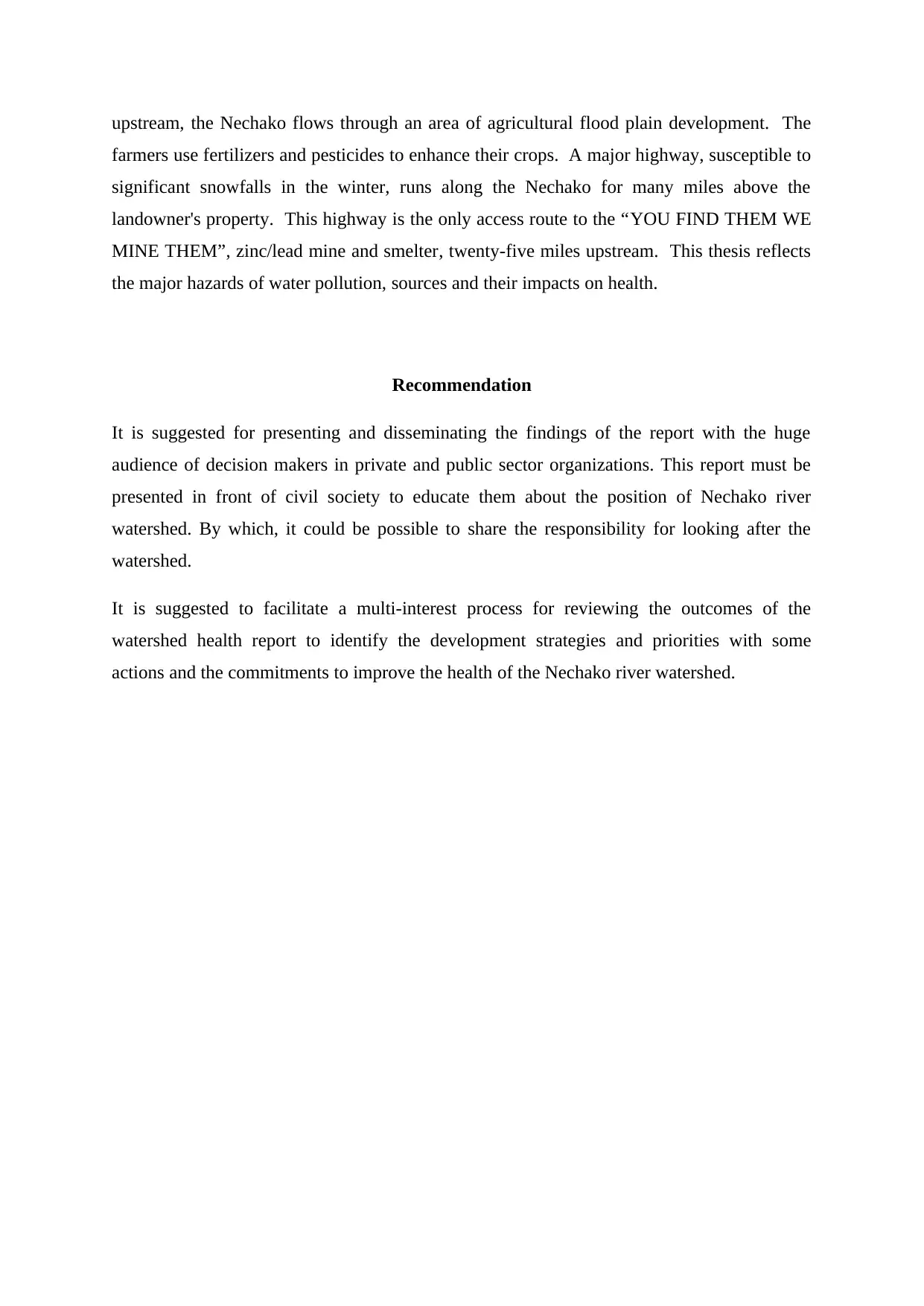
upstream, the Nechako flows through an area of agricultural flood plain development. The
farmers use fertilizers and pesticides to enhance their crops. A major highway, susceptible to
significant snowfalls in the winter, runs along the Nechako for many miles above the
landowner's property. This highway is the only access route to the “YOU FIND THEM WE
MINE THEM”, zinc/lead mine and smelter, twenty-five miles upstream. This thesis reflects
the major hazards of water pollution, sources and their impacts on health.
Recommendation
It is suggested for presenting and disseminating the findings of the report with the huge
audience of decision makers in private and public sector organizations. This report must be
presented in front of civil society to educate them about the position of Nechako river
watershed. By which, it could be possible to share the responsibility for looking after the
watershed.
It is suggested to facilitate a multi-interest process for reviewing the outcomes of the
watershed health report to identify the development strategies and priorities with some
actions and the commitments to improve the health of the Nechako river watershed.
farmers use fertilizers and pesticides to enhance their crops. A major highway, susceptible to
significant snowfalls in the winter, runs along the Nechako for many miles above the
landowner's property. This highway is the only access route to the “YOU FIND THEM WE
MINE THEM”, zinc/lead mine and smelter, twenty-five miles upstream. This thesis reflects
the major hazards of water pollution, sources and their impacts on health.
Recommendation
It is suggested for presenting and disseminating the findings of the report with the huge
audience of decision makers in private and public sector organizations. This report must be
presented in front of civil society to educate them about the position of Nechako river
watershed. By which, it could be possible to share the responsibility for looking after the
watershed.
It is suggested to facilitate a multi-interest process for reviewing the outcomes of the
watershed health report to identify the development strategies and priorities with some
actions and the commitments to improve the health of the Nechako river watershed.

References
Basu, N., & Lanphear, B. P. (2019). The challenge of pollution and health in
Canada. Canadian Journal of Public Health, 110(2), 159-164.
Bourdages, M., Ehrenbrink, B. P. E., Marsh, S. J., Gillies, S. L., Paine, J. K., Bogaerts, P., ...
& Groeneweg, A. (2017, December). Presence of Microplastics in the Fraser River,
British Columbia. In AGU Fall Meeting Abstracts.
Cheng, X. (2018). Review the function of large aquatic plants in water pollution
treatment (Doctoral dissertation).
D, A. (n.d.). Water Pollution: Definition, Types, and Sources. Retrieved March 23, 2020,
from https://study.com/academy/lesson/water-pollution-definition-types-and-
sources.html#transcriptHeader
Haseena, M. (2017). Water pollution and human health.. Environmental Risk Assessment and
Remediation, 1(3), 6-19.
Incera, A. C., Avelino, A. F., & Solís, A. F. (2017). Gray water and environmental
externalities: International patterns of water pollution through a structural
decomposition analysis. Journal of Cleaner Production, 165, 1174-1187.
Marshall, D., Litke, S., & Fresco, T. (2017). Managing the Fraser River Basin. In Water
Policy and Governance in Canada (pp. 249-267). Springer, Cham.
Muruven, D. N., & Tekere, M. (2020). An Evaluation of the Cumulative Surface Water
Pollution on Selected Areas within the Consolidated Main Reef Area, Roodepoort,
South Africa. Air, Soil and Water Research, 6(1).
Nechako Watershed Health Report, Nechako Watershed Health Report (2015). Retrieved
from https://www.bibme.org/apa/website-citation/search?utf8=✓&q=https://
www.fraserbasin.bc.ca/_Library/Water_BCWF/Nechako-Mar31-2015_FINAL.pdf
Swain, L. G., & Eng., P. WATER QUALITY ASSESSMENT OF Nechako River AT
PRINCE GEORGE, WATER QUALITY ASSESSMENT OF Nechako River AT
PRINCE GEORGE (n.d.). British Columbia. Swain, L. G., & Eng., P. WATER
Basu, N., & Lanphear, B. P. (2019). The challenge of pollution and health in
Canada. Canadian Journal of Public Health, 110(2), 159-164.
Bourdages, M., Ehrenbrink, B. P. E., Marsh, S. J., Gillies, S. L., Paine, J. K., Bogaerts, P., ...
& Groeneweg, A. (2017, December). Presence of Microplastics in the Fraser River,
British Columbia. In AGU Fall Meeting Abstracts.
Cheng, X. (2018). Review the function of large aquatic plants in water pollution
treatment (Doctoral dissertation).
D, A. (n.d.). Water Pollution: Definition, Types, and Sources. Retrieved March 23, 2020,
from https://study.com/academy/lesson/water-pollution-definition-types-and-
sources.html#transcriptHeader
Haseena, M. (2017). Water pollution and human health.. Environmental Risk Assessment and
Remediation, 1(3), 6-19.
Incera, A. C., Avelino, A. F., & Solís, A. F. (2017). Gray water and environmental
externalities: International patterns of water pollution through a structural
decomposition analysis. Journal of Cleaner Production, 165, 1174-1187.
Marshall, D., Litke, S., & Fresco, T. (2017). Managing the Fraser River Basin. In Water
Policy and Governance in Canada (pp. 249-267). Springer, Cham.
Muruven, D. N., & Tekere, M. (2020). An Evaluation of the Cumulative Surface Water
Pollution on Selected Areas within the Consolidated Main Reef Area, Roodepoort,
South Africa. Air, Soil and Water Research, 6(1).
Nechako Watershed Health Report, Nechako Watershed Health Report (2015). Retrieved
from https://www.bibme.org/apa/website-citation/search?utf8=✓&q=https://
www.fraserbasin.bc.ca/_Library/Water_BCWF/Nechako-Mar31-2015_FINAL.pdf
Swain, L. G., & Eng., P. WATER QUALITY ASSESSMENT OF Nechako River AT
PRINCE GEORGE, WATER QUALITY ASSESSMENT OF Nechako River AT
PRINCE GEORGE (n.d.). British Columbia. Swain, L. G., & Eng., P. WATER
⊘ This is a preview!⊘
Do you want full access?
Subscribe today to unlock all pages.

Trusted by 1+ million students worldwide

QUALITY ASSESSMENT OF Nechako River AT PRINCE GEORGE, WATER
QUALITY ASSESSMENT OF Nechako River AT PRINCE GEORGE (n.d.). British
Columbia.
Water and Water Pollution: Definition, Causes, Effects, Prevention. (2019, December 9).
Retrieved March 23, 2020, from https://www.toppr.com/guides/biology/natural-
resources/water-and-water-pollution/
Weber, K. P. (2016). Microbial community assessment in wetlands for water pollution
control: past, present, and future outlook. Water, 8(11), 503.
Wright, C. J., Sargeant, J. M., Edge, V. L., Ford, J. D., Farahbakhsh, K., Shiwak, I., ... &
IHACC Research Team. (2018). Water quality and health in northern Canada: stored
drinking water and acute gastrointestinal illness in Labrador Inuit. Environmental
Science and Pollution Research, 25(33), 32975-32987.
QUALITY ASSESSMENT OF Nechako River AT PRINCE GEORGE (n.d.). British
Columbia.
Water and Water Pollution: Definition, Causes, Effects, Prevention. (2019, December 9).
Retrieved March 23, 2020, from https://www.toppr.com/guides/biology/natural-
resources/water-and-water-pollution/
Weber, K. P. (2016). Microbial community assessment in wetlands for water pollution
control: past, present, and future outlook. Water, 8(11), 503.
Wright, C. J., Sargeant, J. M., Edge, V. L., Ford, J. D., Farahbakhsh, K., Shiwak, I., ... &
IHACC Research Team. (2018). Water quality and health in northern Canada: stored
drinking water and acute gastrointestinal illness in Labrador Inuit. Environmental
Science and Pollution Research, 25(33), 32975-32987.
1 out of 10
Related Documents
Your All-in-One AI-Powered Toolkit for Academic Success.
+13062052269
info@desklib.com
Available 24*7 on WhatsApp / Email
![[object Object]](/_next/static/media/star-bottom.7253800d.svg)
Unlock your academic potential
Copyright © 2020–2025 A2Z Services. All Rights Reserved. Developed and managed by ZUCOL.





